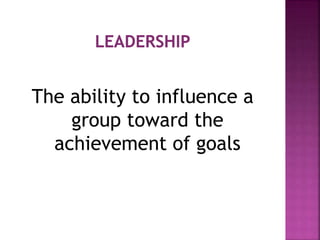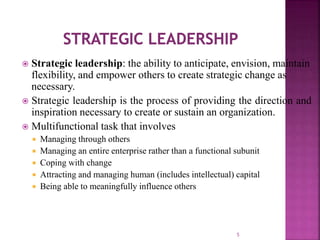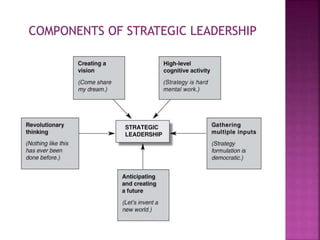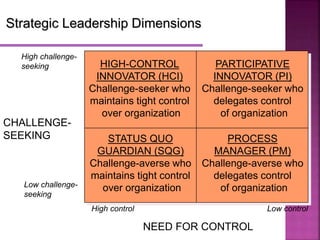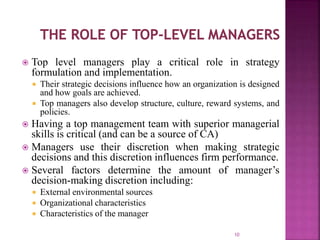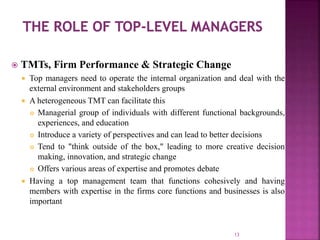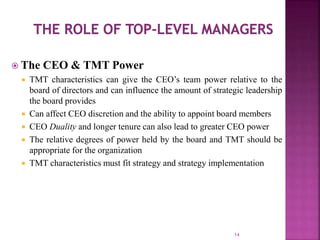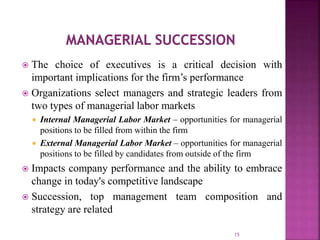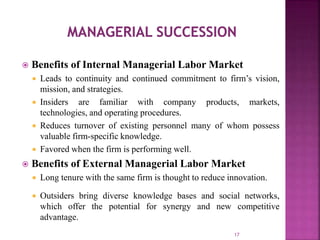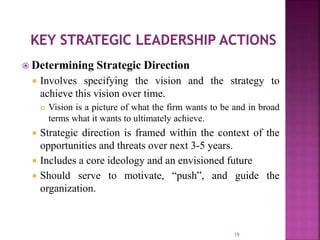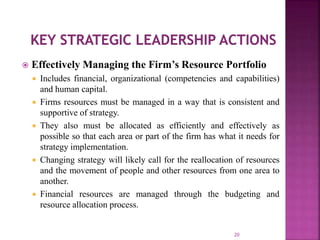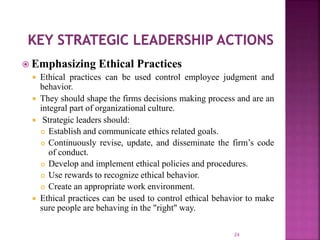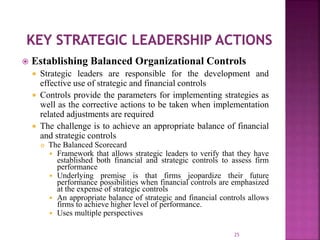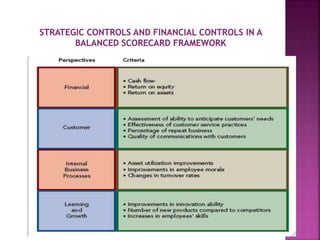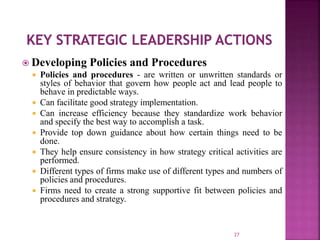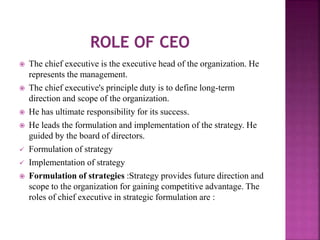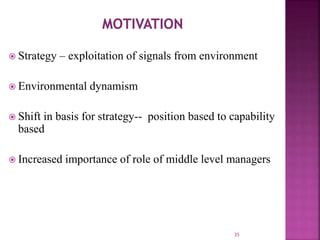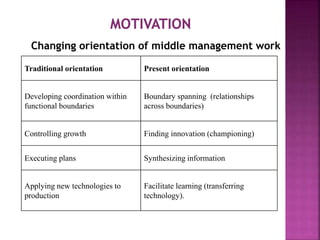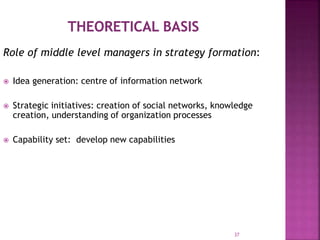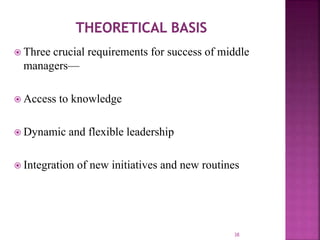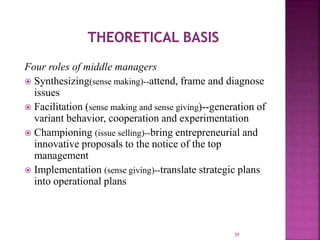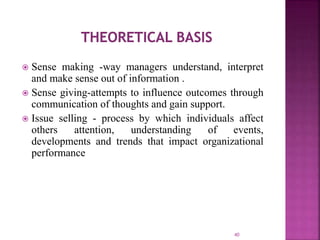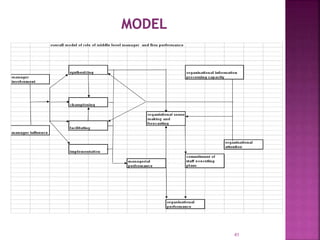Strategic leadership
- 2. The ability to influence a group toward the achievement of goals
- 3. Authoritarian-high task, low relationship Team Leader- high task, high relationship Country Club- low task, high relationship Impoverished- low task, low relationship
- 4. Manager Characteristics Administers A copy Maintains Focuses on systems and structures Relies on control Short range view Asks how and when Eye on bottom line Imitates Accepts the status quo Classic good soldiers Does things right Leader Characteristics • Innovates • An original • Develops • Focuses on people • Inspires trust • Long range perspective • Asks what and why • Eye on horizon • Originates • Challenges the status quo • Own person • Does the right thing
- 5. Strategic leadership: the ability to anticipate, envision, maintain flexibility, and empower others to create strategic change as necessary. Strategic leadership is the process of providing the direction and inspiration necessary to create or sustain an organization. Multifunctional task that involves Managing through others Managing an entire enterprise rather than a functional subunit Coping with change Attracting and managing human (includes intellectual) capital Being able to meaningfully influence others 5
- 6. Strategic leaders make a major difference in how well a firm performs. Strategic leadership deals with the major purposes of an organization or organizational unit Five important components of strategic leadership include high-level cognitive ability multiple inputs to strategy formulation anticipating and creating a future revolutionary thinking, and creation of a vision
- 8. Strategic Leadership Dimensions NEED FOR CONTROL High control Low control High challenge- seeking Low challenge- seeking CHALLENGE- SEEKING HIGH-CONTROL INNOVATOR (HCI) Challenge-seeker who maintains tight control over organization STATUS QUO GUARDIAN (SQG) Challenge-averse who maintains tight control over organization PARTICIPATIVE INNOVATOR (PI) Challenge-seeker who delegates control of organization PROCESS MANAGER (PM) Challenge-averse who delegates control of organization
- 9. Effective strategic leadership is the foundation for successfully using the strategic management process Strategic leaders: Shape the formation of vision and mission Facilitate strategy formulation and strategy implementation Are needed for the achievement of strategic competitiveness and above-average returns. 9
- 10. Top level managers play a critical role in strategy formulation and implementation. Their strategic decisions influence how an organization is designed and how goals are achieved. Top managers also develop structure, culture, reward systems, and policies. Having a top management team with superior managerial skills is critical (and can be a source of CA) Managers use their discretion when making strategic decisions and this discretion influences firm performance. Several factors determine the amount of manager’s decision-making discretion including: External environmental sources Organizational characteristics Characteristics of the manager 10
- 11. 11
- 12. Top Management Teams (TMT) In most firms there is a team of strategic leaders called the top management team. A team is needed to deal with the complexity of challenges and the need for substantial amounts of information and knowledge to make strategic decisions TMT composed of key individuals who are responsible for selecting and implementing firm’s strategies. Usually includes officers of the corporation (VP and above) and members of BOD. TMT characteristics must fit strategy and strategic implementation. TMTs affect firm performance and strategic change. 12
- 13. TMTs, Firm Performance & Strategic Change Top managers need to operate the internal organization and deal with the external environment and stakeholders groups A heterogeneous TMT can facilitate this Managerial group of individuals with different functional backgrounds, experiences, and education Introduce a variety of perspectives and can lead to better decisions Tend to "think outside of the box," leading to more creative decision making, innovation, and strategic change Offers various areas of expertise and promotes debate Having a top management team that functions cohesively and having members with expertise in the firms core functions and businesses is also important 13
- 14. The CEO & TMT Power TMT characteristics can give the CEO’s team power relative to the board of directors and can influence the amount of strategic leadership the board provides Can affect CEO discretion and the ability to appoint board members CEO Duality and longer tenure can also lead to greater CEO power The relative degrees of power held by the board and TMT should be appropriate for the organization TMT characteristics must fit strategy and strategy implementation 14
- 15. The choice of executives is a critical decision with important implications for the firm’s performance Organizations select managers and strategic leaders from two types of managerial labor markets Internal Managerial Labor Market – opportunities for managerial positions to be filled from within the firm External Managerial Labor Market – opportunities for managerial positions to be filled by candidates from outside of the firm Impacts company performance and the ability to embrace change in today's competitive landscape Succession, top management team composition and strategy are related 15
- 16. 16
- 17. Benefits of Internal Managerial Labor Market Leads to continuity and continued commitment to firm’s vision, mission, and strategies. Insiders are familiar with company products, markets, technologies, and operating procedures. Reduces turnover of existing personnel many of whom possess valuable firm-specific knowledge. Favored when the firm is performing well. Benefits of External Managerial Labor Market Long tenure with the same firm is thought to reduce innovation. Outsiders bring diverse knowledge bases and social networks, which offer the potential for synergy and new competitive advantage. 17
- 18. 18
- 19. Determining Strategic Direction Involves specifying the vision and the strategy to achieve this vision over time. Vision is a picture of what the firm wants to be and in broad terms what it wants to ultimately achieve. Strategic direction is framed within the context of the opportunities and threats over next 3-5 years. Includes a core ideology and an envisioned future Should serve to motivate, “push”, and guide the organization. 19
- 20. Effectively Managing the Firm’s Resource Portfolio Includes financial, organizational (competencies and capabilities) and human capital. Firms resources must be managed in a way that is consistent and supportive of strategy. They also must be allocated as efficiently and effectively as possible so that each area or part of the firm has what it needs for strategy implementation. Changing strategy will likely call for the reallocation of resources and the movement of people and other resources from one area to another. Financial resources are managed through the budgeting and resource allocation process. 20
- 21. Effectively Managing the Firm’s Resource Portfolio Core competencies and competitive capabilities should be developed in a strategy supportive fashion. Firms should build their strategy around things they are good at doing and/or become good at doing things that are supportive of strategy. A firm’s human capital, which refers to the knowledge and skills of a firm’s entire workforce, should also fit its strategy. This can be accomplished by: Hiring people who fit the organization and its strategy. An effective training and development program. Investments should be made to acquire and develop the firm’s human capital. 21
- 22. Sustaining an Effective Organizational Culture Organizational culture: consists of a complex set of ideologies, symbols, and core values shared throughout the firm and influence the way business is conducted Shapes the context within which the firm formulates and implements it's strategies. Also helps to regulate and control employees’ behavior There are many things that make up a company’s culture and many places that is comes from Once developed, a company’s culture tends to last because: Organizations hire people who fit the firm and its culture Employees learn by observing the behavior of others and through socialization and systematic indoctrination of cultural values Storytelling of company legends and ceremonies that honor employees who display cultural ideals Visibly rewarding those who follow cultural norms 22
- 23. Sustaining an Effective Organizational Culture Cultures can vary in strength depending on the degree to which they are imbedded in company practices and norms. Firms must match culture to strategy, as a culture that promotes attitudes and behaviors that are well-suited to strategy will help in the achievement of strategic competitiveness and above average returns. Related firms develop cooperative cultures Unrelated firms develop competitive cultures Cost leaders value economy, frugality and efficiency Differentiators value innovation, quality, and excellence Changing culture can be difficult but can be accomplished if the appropriate strategic leadership is in place. 23
- 24. Emphasizing Ethical Practices Ethical practices can be used control employee judgment and behavior. They should shape the firms decisions making process and are an integral part of organizational culture. Strategic leaders should: Establish and communicate ethics related goals. Continuously revise, update, and disseminate the firm’s code of conduct. Develop and implement ethical policies and procedures. Use rewards to recognize ethical behavior. Create an appropriate work environment. Ethical practices can be used to control ethical behavior to make sure people are behaving in the "right" way. 24
- 25. Establishing Balanced Organizational Controls Strategic leaders are responsible for the development and effective use of strategic and financial controls Controls provide the parameters for implementing strategies as well as the corrective actions to be taken when implementation related adjustments are required The challenge is to achieve an appropriate balance of financial and strategic controls The Balanced Scorecard Framework that allows strategic leaders to verify that they have established both financial and strategic controls to assess firm performance Underlying premise is that firms jeopardize their future performance possibilities when financial controls are emphasized at the expense of strategic controls An appropriate balance of strategic and financial controls allows firms to achieve higher level of performance. Uses multiple perspectives 25
- 26. 26
- 27. Developing Policies and Procedures Policies and procedures - are written or unwritten standards or styles of behavior that govern how people act and lead people to behave in predictable ways. Can facilitate good strategy implementation. Can increase efficiency because they standardize work behavior and specify the best way to accomplish a task. Provide top down guidance about how certain things need to be done. They help ensure consistency in how strategy critical activities are performed. Different types of firms make use of different types and numbers of policies and procedures. Firms need to create a strong supportive fit between policies and procedures and strategy. 27
- 28. Developing Reward Systems It can be argued that rewards are the single most powerful tool for winning the commitment of employees to effective strategy implementation. Rewards are an important tool used to achieve behavioral control. Firms should create a results oriented system in which those achieving objectives are generously rewarded and those not achieving objectives are not rewarded. Rewards and incentives should also be tied to strategy: Cost leaders should reward people for being efficient and for identifying ways to reduce costs. Differentiators should reward people for being innovative. The bottom line is that firms need to reward and motivate people in ways that are supportive of strategy and strategy implementation. 28
- 29. McKinsey 7-S Strategy Implementation Framework Basic Premise: there are seven internal aspects of an organization that need to be aligned if the organization is to be successful. These seven elements are interdependent and can be categorized as either "hard" or "soft" elements. They are interdependent to the extent that making changes to one affects all of the others. For an organization to perform well each of these elements must fit with and be consistent with one another. These elements include: Strategy, Structure, Systems, Shared Values, Style, Staff , and Skills 29
- 30. 30
- 31. The chief executive is the executive head of the organization. He represents the management. The chief executive's principle duty is to define long-term direction and scope of the organization. He has ultimate responsibility for its success. He leads the formulation and implementation of the strategy. He guided by the board of directors. Formulation of strategy Implementation of strategy Formulation of strategies :Strategy provides future direction and scope to the organization for gaining competitive advantage. The roles of chief executive in strategic formulation are :
- 32. Key strategic role :The chief executive plays the role of chief architect in defining vision, mission, and objective of the organization. He conceptualizes and crafts strategic to achieve objectives. Decision making role :The chief executive makes strategic decisions related to strategy formulation .He makes strategic choice from among strategic options for achieving objectives. This role involves risk-taking. Resources planning role :This role of chief executive involves coordinated allocation of significant resources to planes. Such plans can be organization wide or related to strategic business units or function. Resources can be people, money, technology, time and information. Negotiator role :Strategic must fulfill the expectation of various stakeholders of the organization. The chief executive balance there conflicting interest by negotiating disputes. The stakeholder can be owners, customers, employees, suppliers, government, labour unions, and financial institution.
- 33. Implementation of strategy: Implementation is putting strategy into action. The chief information about strategy to the implementers within the organization. He serve as a spokesperson for strategic implementation. Leadership role :The chief executive assumes overall leadership for the implementation of strategy. He inspire trust and self-confidence among implements of strategy. He ensures there participation. He motivates them for higher productivity. He provides direction for implementation of strategy. Organizer role :The chief executive is an organization builder. He determines the structure for strategy implementation. He establishes reporting relationship and span of control. He assigns authority and responsibility for petitions and people in the organization for key result areas. Resource manager role :The chief executive ensures officiated and effective mobilization, allocation and utilization of resources for implementation strategy. Budgets are prepare for management or resources. Monitoring :The chief executive monitors and evaluates the performance results of strategy implementation. He takes corrective actions to resolve performance problems. He handles unexpected distributors and crisis situation.
- 34. Middle management is the intermediate management level, accountable to top management and responsible for leading lower level managers. Middle management is the intermediate management of a hierarchical organization, subordinate to the senior management but above the lowest levels of operational staff. They are accountable to the top management for their department's function. They provide guidance to lower level managers and inspire them towards better performance. Middle management may be reduced in organizations as a result of reorganization. Such changes include downsizing, delayering, and outsourcing.
- 35. 35 Strategy – exploitation of signals from environment Environmental dynamism Shift in basis for strategy-- position based to capability based Increased importance of role of middle level managers
- 36. 36 Traditional orientation Present orientation Developing coordination within functional boundaries Boundary spanning (relationships across boundaries) Controlling growth Finding innovation (championing) Executing plans Synthesizing information Applying new technologies to production Facilitate learning (transferring technology). Changing orientation of middle management work
- 37. 37 Role of middle level managers in strategy formation: Idea generation: centre of information network Strategic initiatives: creation of social networks, knowledge creation, understanding of organization processes Capability set: develop new capabilities
- 38. 38 Three crucial requirements for success of middle managers— Access to knowledge Dynamic and flexible leadership Integration of new initiatives and new routines
- 39. 39 Four roles of middle managers Synthesizing(sense making)--attend, frame and diagnose issues Facilitation (sense making and sense giving)--generation of variant behavior, cooperation and experimentation Championing (issue selling)--bring entrepreneurial and innovative proposals to the notice of the top management Implementation (sense giving)--translate strategic plans into operational plans
- 40. 40 Sense making -way managers understand, interpret and make sense out of information . Sense giving-attempts to influence outcomes through communication of thoughts and gain support. Issue selling - process by which individuals affect others attention, understanding of events, developments and trends that impact organizational performance
- 41. 41


